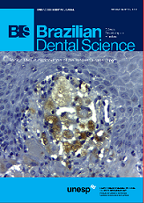Alternative technique for preliminary impression in edentulous patients
DOI:
https://doi.org/10.14295/bds.2017.v20i2.1429Abstract
Objective: The aim of this study was to analyze the reproducibility of the anatomic models of edentulous maxillary and mandibular arches. Material and Methods: Alginate molds of the edentulous arches of standard model were performed and the tray was placed to the special device. These models received three metal spheres on surface with two positioned on the crest of the alveolar ridge (spheres 1 and 2) and other one perpendicular to the intersection of the midpalatal suture (sphere 3) and impression was performed using alginate. The proportion powder/liquid was measured according manufacturer for both arches. To double molding technique with alginate was necessary to uniformly relieve using an acetate film. After that, were performed the first impression and the second layer of alginate with conventional water-powder-proportion and also the second layer of alginate with altered water-powder-proportion. The distances of each spheres were obtained using a three-dimensional measuring-machine, and the data were analyzed by Dunnet, ANOVA and Tukey tests with a significant level of 5%. Results: A comparison of the water-powder-proportion showed significant differences in the maxillary archer with sphere distance between 3-2 (p < 0.0001) and 1-3 (p < 0.0001). The mandibular archer showed significant differences when relief between distance 1-2 (p<0.041). The Dunnet test showed different in 1-2 mandibular groups (p < 0.0450). Conclusion: The reline alginate techniques showed differences in results in comparison to the conventional technique, however, the proportion water/powder technique modified, decreasing the viscosity, showed satisfactory results, the relief variable showed no difference statistically significantly and the techniques proposed could be employed in clinical practice.
Keywords
Alginate; Complete denture; Edentulism.
Downloads
Downloads
Published
How to Cite
Issue
Section
License
Brazilian Dental Science uses the Creative Commons (CC-BY 4.0) license, thus preserving the integrity of articles in an open access environment. The journal allows the author to retain publishing rights without restrictions.
=================




























